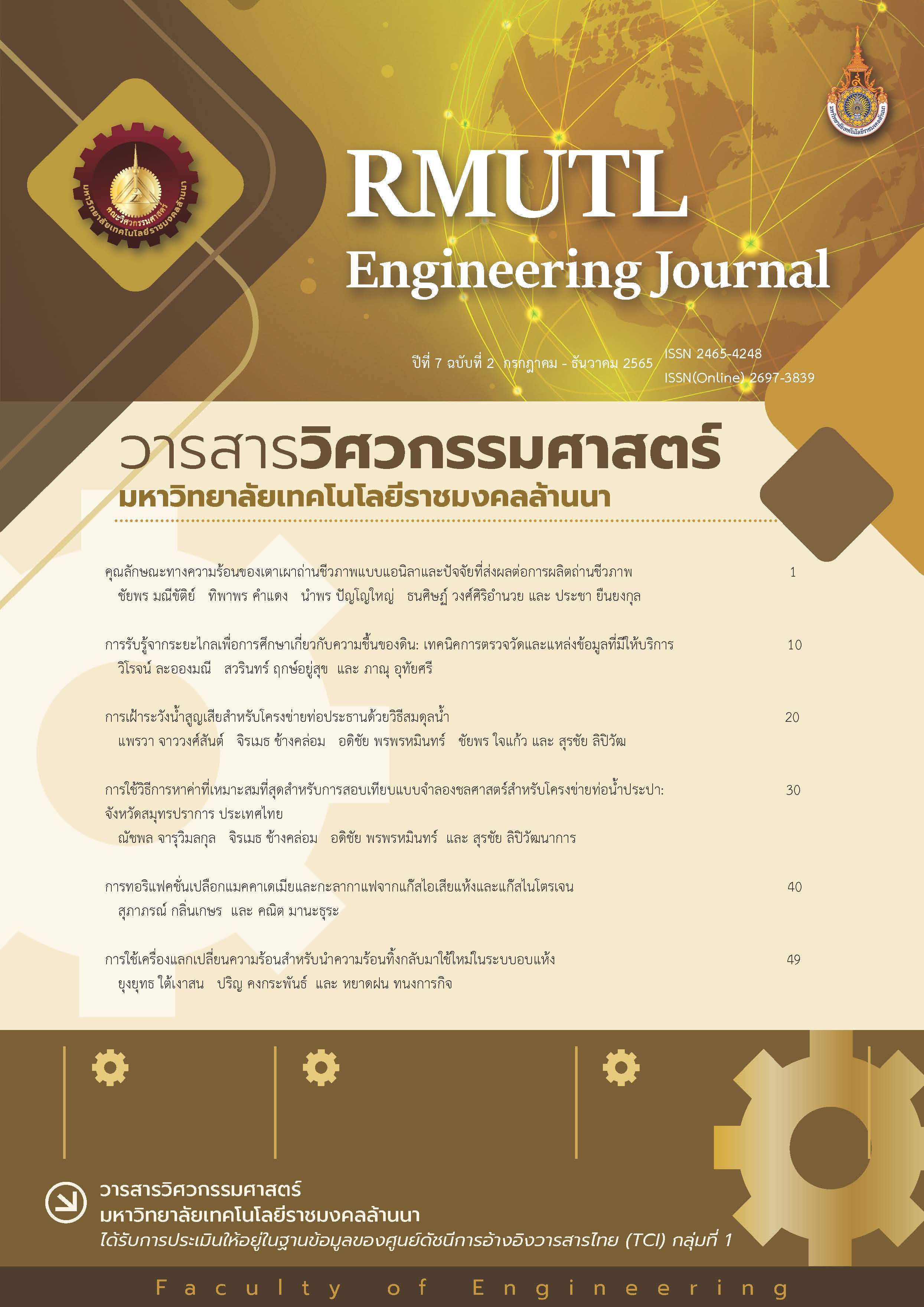Thermal Characteristics of Anila-type Biochar Kiln and Factors Affecting Biochar Production
DOI:
https://doi.org/10.14456/rmutlengj.2022.7Keywords:
Thermal Simulation, Anila Stove, Biochar, CorrelationAbstract
The objectives of this research were to study the temperature distribution simulation in insulated Anila-type biochar kiln with size of 50, 100 and 200 liters and to study the effects of biomass material types, kiln size, and pyrolysis time on temperature distribution in the insulated biochar kiln, biochar yield, and biochar property. The correlations between the variables related to the biochar production were furthermore investigated. The core of the kiln had a puncture diameter of 3.17 mm, number of the puncture of 15, 24 and 44, respectively. The results showed that a 200-liter biochar kiln with biomass as the husk rice had the highest biochar yield of 51.1%. Based on the simulation results, the average temperature distribution at pyrolysis time of 1, 2 and 3 hours was 459.4±184.9 °C, 468.7±100.3 °C and 353.1±97.8 °C, respectively, when compared with the experiment results the error was 6.5±6.2, 3.9±4.1 and 0.9±0.9%, respectively. From the correlation equation, it was found that average temperature inside the kiln had no significant effect on the biochar yield and acidity-alkalinity. On the other hand, the kiln dimensional parameters, i.e. A/Ap, L/D, pyrolysis time and biomass material type had an effect on the biochar yield. Furthermore, the A/Ap, L/D and pyrolysis time had an effect on the acidity-alkalinity of biochar as well. From the results of this research, the temperature distribution characteristics of different kiln sizes and conditions affecting the biochar yield and acidity-alkalinity obtained from the biochar production were revealed.
References
Budai A, Rasse DP, Lagomarsino A, Lerch TZ, Paruch L. Biochar persistence, priming and microbial responses to pyrolysis temperature series. Biol Fertil Soils. 2016 Aug;52(6):749–61.
Mengesha TT, Ramayya AV. Performance evaluation of pyrolysis cookstove using water boiling test. Am J Mod Phys. 2017 Sep 12;6(5):108.
Biochar production using pyrolysis cook stove from coffee husk, Wood working waster and wastes from bedele brewery.
Wallace C. Microwave pyrolysis biochar characterization and modeling of char reinforced GFRP biocomposites [Internet]. University of New Brunswick.; 2019 [cited 2022 Nov 21]. Available from:https://unbscholar.lib.unb.ca/islandora/object/unbscholar%3A9802/
Petchaihan L, Panyoyai N, Khamdaeng T, Wongsiriamnuay T. Test of a modified small-scale biochar kiln. IOP Conf Ser Earth Environ Sci. 2020 Mar 1;463(1):012004.
Srisophon M, Khamdaeng T, Panyoyai N, Wongsiriamnuay T. Characterization of thermal distribution in 50-Liter biochar kiln at different heating times. IOP Conf Ser Earth Environ Sci. 2020 Mar 1;463(1):012079.
Budai A, Wang L, Gronli M, Strand LT, Michael J. Antal J, Abiven S, et al. Surface properties and chemical composition of corncob and miscanthus biochars: Effects of production temperature and method [Internet]. ACS Publications. American Chemical Society; 2014 [cited 2022 Nov 21]. Availablefrom:https://pubs.acs.org/doi/full/10.1021/jf501139f
Intagun W, Khamdaeng T, Prom-ngarm P, Panyoyai N. Effect of core puncture diameter on Bio-Char kiln efficiency. Int J Biotechnol Bioeng. 2018 Oct 1;12(11):435–9.
Mengesha TT, Ramayya A. Heat transfer validation and comparative evaluation of biochar yield from pyrolysis cook stove. J of Agricultural Science and Technology: B. 2015; 5:389-400.
Daosukho S, Rodprasert S. The development of soil quality using biochar amendment from agricultural waste. Bull Appl Sci. 2015 Aug 1;4
(4):95–102.
Fabrication of magnetic biochar as a treatment medium for As(V) via pyroly sis of FeCl3- pretreated spent coffee ground. Environ Pollut.
Oct 1;229:942–9.
Panyoyai N, Wongsiriamnuay T, Khamdaeng T. Temperature distribution inside biochar kiln for biochar production. The 10 th International Conference on Sciences, Technology and Innovation for Sustainable Well-Being (STISWB 2018). July 11th -13th; Vientiane, LaoVientiane, Lao PDR, 2018. p. 56–60.
Panyoyai N, Petchaihan L, Wongsiriamnuay T, Hiransatitporn B, Khamdaeng T. Simulation of temperature distribution in biochar kiln with different feedstock types:J Engineering . 2019 Dec 28;5(2):59–64. Available from: doi:10.14456 /mijet.2019.9. [Accessed 14th Dec 2022].
Djousse Kanouo, BM, Allaire SE, Munson AD. quality of biochars made from eucalyptus tree bark and corncob using a pilot-scale retort kiln. Waste Biomass Valorization. 2018 Jun 1;9(6): 899–909.Available from:doi.org/10.1007/ s12649-017-9884-2[Accessed 14th Dec 2022].
Wijitkosum S, Jiwnok P. Elemental composition of biochar obtained from agricultural waste for soil amendment and carbon sequestration. Appl Sci. 2019 Jan;9(19):3980.
Downloads
Published
How to Cite
Issue
Section
License
Copyright (c) 2022 RMUTL.Eng.J.

This work is licensed under a Creative Commons Attribution-NonCommercial-NoDerivatives 4.0 International License.










